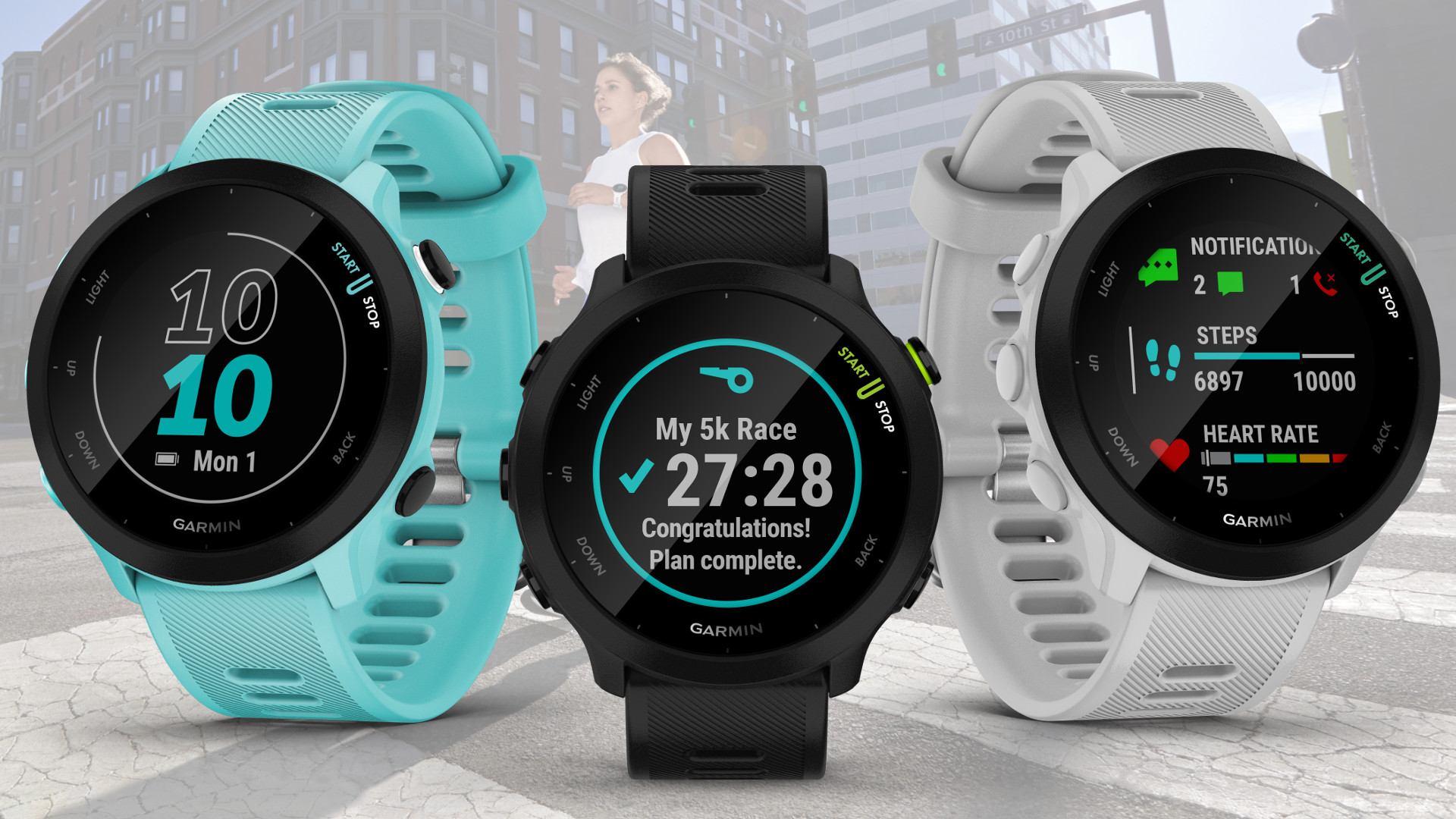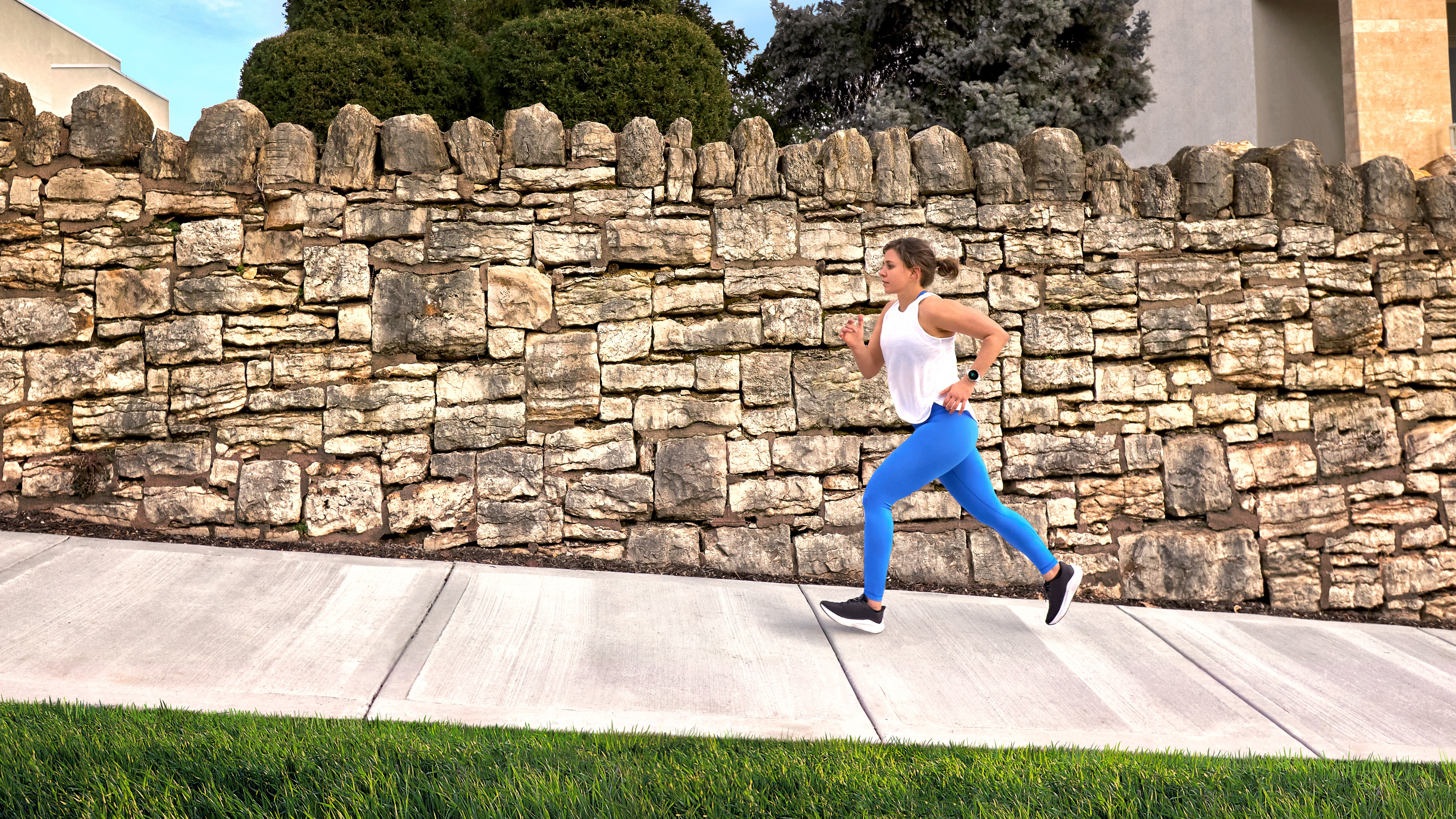The Garmin Forerunner 55 is the best watch for new runners – and here's why

When you're a new runner, the sheer number of running watches available can be daunting. Prices vary hugely, and many are packed with features and tools that you simply won't need if you're just starting out. That's where the Garmin Forerunner 55 comes in. It's not the most advanced watch out there (it won't help you navigate off-road like the Garmin Fenix 6, or tell you when to use energy gels like the Polar Grit X), but it's ideally suited to the needs of runners who are just starting out.
Watches in the Forerunner series have always ranked well in our guide to the best running watches, and we were particularly impressed by the entry-level Forerunner 55 when we reviewed it earlier this year. It doesn't just track time and distance – it helps give your training structure in the early days, and adapts to help you reach your first goal, however modest or ambitious it may be. If you're new to running, we think it's the best watch you can choose.
Price
The Garmin Forerunner 55 cost $199.99 / £179.99 / AU$329 when it launched in early June. It's only seen a very slight drop in price since then if you buy it from a third-party retailer like Amazon. That's still a very reasonable price; while there are cheaper running watches available, none can match the GPS accuracy and training tools offered by the Forerunner 55.
You'll also get access to everything in the Garmin Connect app free of charge. While Fitbit hides some of its app features away behind a monthly subscription fee, all your historic data and trends are available to view without paying a penny more, with extra stats including fitness age, sleep score, hydration tracking and more all at your fingertips. There are even free workouts and training plans to follow.
If you decide to upgrade to a higher-end Garmin watch later, the app will transfer all your data across automatically. You can even switch between two Garmin watches whenever you feel like it. Provided one is marked as your 'main' device, the app will have no trouble syncing data from either one.
Design
The Garmin Forerunner 55 looks almost identical to its predecessor, the Forerunner 45, and it's a design that's well suited to beginners. It foregoes the usual touchscreen for a series of buttons around the circumference of the case, which helps keep costs down, but not at the expense of usability. Each control is clearly labelled to avoid confusion (which can easily arise with multi-function buttons), and the top right control for starting and stopping an activity is highlighted in a contrasting color to avoid mistakes mid-run.

The use of buttons rather than a touchscreen also means that the Forerunner 55 is easy to use while wearing gloves, in wet weather, or while swimming (the watch has a water resistance rating of 5ATM, making it suitable for depths up to 50 meters).
Sign up for breaking news, reviews, opinion, top tech deals, and more.
The Forerunner 55 is a relatively small running watch, with a face measuring 42mm in diameter, making it suitable for a wide range of wrist sizes. Like all models in the Forerunner series, it comes with a single silicone band with a buckle fastening and perforations along the entire length, which can fit wrist sizes from 126-203mm
For comparison, the standard band on the Garmin Venu 2 fits wrists measuring 110-175mm in circumference, and the 45mm Vivoactive 4 is suitable for wrists measuring 135-200mm.
Training tools
Garmin started out as a company specializing in GPS navigation systems, and it's still one of its strongest suits. The Foreunner 55 is one of the cheapest GPS running watches available, and in our real-world tests it proved accurate to within a few meters on our pre-measured course (a margin of error small enough to be explained by the width of pavements).
This allows you to track exactly how far and fast you're running (data clearly displayed on the watch's screen during a workout, then synced to the Garmin Connect app immediately afterwards), but the Forerunner 55 has a lot more to offer new runners than just time and distance.

One new feature introduced with the Forerunner 55 is suggested workouts, which can help give your training some structure even if you're not following a specific plan. As a new runner, it can be easy to get into the habit of running the same route at the same pace, but the Forerunner 55 can help you mix things up with suggestions for interval sessions and tempo runs. These are personalized to suit you, based on factors including your fitness level, past activity, and recovery times.
If you have a specific goal in mind (running your first 10k, for example), the Garmin Coach tool can help you get there with a more focused plan. In the Garmin Connect app, set a date to achieve your target and how many days a week you want to run, and Garmin Coach will generate a custom plan that will adapt to suit you, and will sync with your watch so it's only a couple of button presses away.
For example, once you've finished a run, the Forerunner 55 uses your workout and heart rate data to calculate how long you should rest before your next effort to help you avoid under- or over-training.
Biometrics
Even if two people run the same distance in the same time, their relative levels of fitness might mean that one is working significantly harder than the other. That's where heart rate can come in handy, making sure you're not pushing yourself too hard on longer runs, or holding back in intense interval sessions.
The Forerunner 55 makes it easy to train by heart rate, and can suggest training sessions based on this rather than distance or speed.
The Forerunner 55 also measures your heart rate continuously throughout the day, and uses this data to give you practical advice. The World Health Organization recommends that adults carry out a certain amount of physical activity each week. The Forerunner 55 translates this into 'intensity minutes', and advises how long you should aim to spend performing moderate or vigorous activity.

The Garmin Connect app can use heart rate data to estimate your VO2 max, which is the maximum amount of oxygen your body can use during exercise. It's a good measure of fitness, but the number itself might not be very useful to new runners. To put it into context, the app will tell you how your score compares to other people of the same age and gender, and use it together with your resting heart rate and BMI to calculate your 'fitness age'. It will then give you practical tips on how to improve you fitness and lower your 'age'.
It's not just about workouts, either; the watch also uses heart rate variability to track your stress levels throughout the day too, which can help you understand the daily circumstances that make you feel anxious. The Forerunner 55 can also lead you through a guided breathing exercise designed to lower your heart rate when it detects that you're feeling the pressure.
That's before you factor in tools that help you recover after your workout, including sleep tracking and Body Battery energy monitoring. If you're just starting out, it's all extremely useful advice, presented in a way that's easy to understand and genuinely useful.
- We've tested and ranked the best running shoes available today

Cat is TechRadar's Homes Editor specializing in kitchen appliances and smart home technology. She's been a tech journalist for 15 years, having worked on print magazines including PC Plus and PC Format, and is a Speciality Coffee Association (SCA) certified barista. Whether you want to invest in some smart lights or pick up a new espresso machine, she's the right person to help.